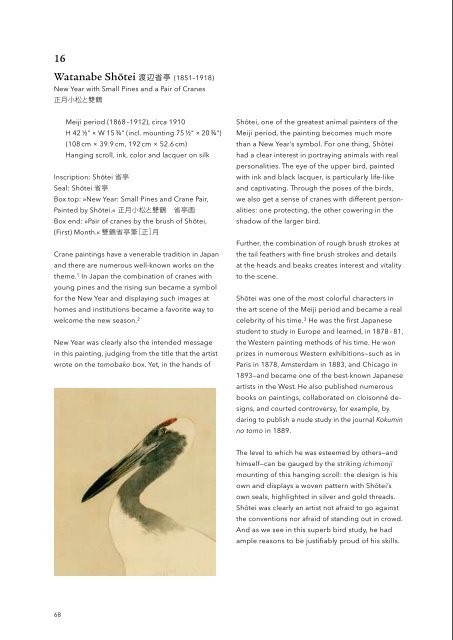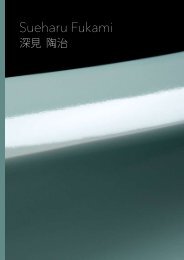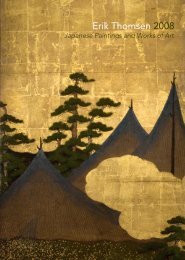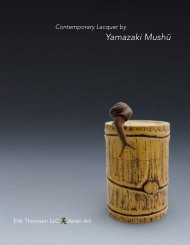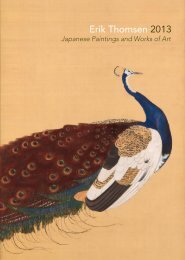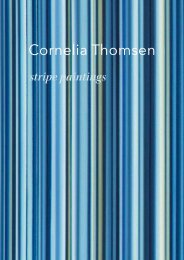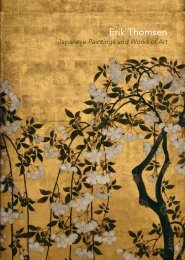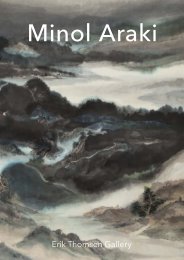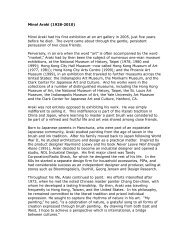View publication (pdf file 6.5 mb) - Erik Thomsen
View publication (pdf file 6.5 mb) - Erik Thomsen
View publication (pdf file 6.5 mb) - Erik Thomsen
- No tags were found...
Create successful ePaper yourself
Turn your PDF publications into a flip-book with our unique Google optimized e-Paper software.
16Watanabe Shōtei 渡 辺 省 亭 (1851–1918)New Year with Small Pines and a Pair of Cranes正 月 小 松 と 雙 鶴Meiji period (1868 –1912), circa 1910H 42 ½" × W 15 ¾" (incl. mounting 75 ½" × 20 ¾")(108 cm × 39.9 cm, 192 cm × 52.6 cm)Hanging scroll, ink, color and lacquer on silkInscription: Shōtei 省 亭Seal: Shōtei 省 亭Box top: »New Year: Small Pines and Crane Pair,Painted by Shōtei.« 正 月 小 松 と 雙 鶴 省 亭 画Box end: »Pair of cranes by the brush of Shōtei,(First) Month.« 雙 鶴 省 亭 筆 [ 正 ] 月Crane paintings have a venerable tradition in Japanand there are numerous well-known works on thetheme. 1 In Japan the co<strong>mb</strong>ination of cranes withyoung pines and the rising sun became a sy<strong>mb</strong>olfor the New Year and displaying such images athomes and institutions became a favorite way towelcome the new season. 2New Year was clearly also the intended messagein this painting, judging from the title that the artistwrote on the tomobako box. Yet, in the hands ofShōtei, one of the greatest animal painters of theMeiji period, the painting becomes much morethan a New Year’s sy<strong>mb</strong>ol. For one thing, Shōteihad a clear interest in portraying animals with realpersonalities. The eye of the upper bird, paintedwith ink and black lacquer, is particularly life-likeand captivating. Through the poses of the birds,we also get a sense of cranes with different personalities:one protecting, the other cowering in theshadow of the larger bird.Further, the co<strong>mb</strong>ination of rough brush strokes atthe tail feathers with fine brush strokes and detailsat the heads and beaks creates interest and vitalityto the scene.Shōtei was one of the most colorful characters inthe art scene of the Meiji period and became a realcelebrity of his time. 3 He was the first Japanesestudent to study in Europe and learned, in 1878 – 81,the Western painting methods of his time. He wonprizes in numerous Western exhibitions—such as inParis in 1878, Amsterdam in 1883, and Chicago in1893—and became one of the best-known Japaneseartists in the West. He also published numerousbooks on paintings, collaborated on cloisonné designs,and courted controversy, for example, bydaring to publish a nude study in the journal Kokuminno tomo in 1889.The level to which he was esteemed by others—andhimself—can be gauged by the striking ichimonjimounting of this hanging scroll: the design is hisown and displays a woven pattern with Shōtei’sown seals, highlighted in silver and gold threads.Shōtei was clearly an artist not afraid to go againstthe conventions nor afraid of standing out in crowd.And as we see in this superb bird study, he hadample reasons to be justifiably proud of his skills.68


